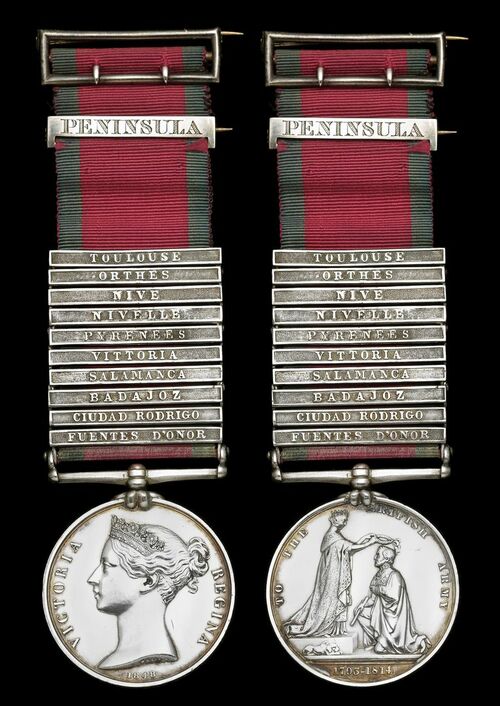
Auction: 24001 - Orders, Decorations and Medals
Lot: 9
The fascinating Military General Service Medal awarded to Major-General J. N. Jackson, 94th Regiment of Foot, who commenced active service in the Peninsular War at a mere fourteen years of age, and in later life rose to high rank - not before helping to foil a mutiny aboard a Convict Ship en route to Van Diemen's Land in 1842
Military General Service 1793-1814, 10 clasps, Fuentes D'Onor, Ciudad Rodrigo, Badajoz, Salamanca, Vittoria, Pyrenees, Nivelle, Nive, Orthes, Toulouse (J. N. Jackson, Captn. 94th Foot), rank officially corrected from 'Lieut.', additionally mounted upon silver riband buckle and one further silver buckle contemporarily engraved 'Peninsula', good very fine
Provenance:
Glendining, 1970.
Charles Lusted, October 1972.
John Napper Jackson is confirmed upon the Medal Roll with entitlement to these ten clasps, one of only two captains in the 94th Foot to claim this number and combination. Born in Dublin, Ireland circa 1796, he was purchased a Commission as Ensign in the 94th Regiment of Foot on 1 July 1805 - at the age of nine. Whilst the Commander-in-Chief of the British Army at the time - Prince Frederick, Duke of York and Albany - put much effort into removing the worst abuses of the infamous 'Purchase System', clearly the occasional example still slipped through the net. Promoted Lieutenant a mere six months later (1 January 1806), Jackson was only 14 years old at the time of his first major battle - Fuentes de Onoro, 3-5 May 1810.
However, his lack of years did nothing to prevent a very active career - during his service in the Peninsula he was present at some thirty battles and actions, including the Siege of Cadiz; Lines of Torres Vedras; the siege and storming of Ciudad Rodrigo; the third Siege of Badajoz and storm of the castle by escalade; Fort China (in command of an escort of the Third Division); Nive; Nivelle; and numerous other minor actions and 'affairs', as they were known at the time.
Having been promoted Captain on 28 February 1812 and remaining in the Army post-war, he served for a time on Half-Pay with the 43rd Light Infantry (1822) before being appointed to command of the Light Company of the 99th (Lanarkshire) Regiment of Foot on its formation in 1824 – already by this time an experienced fighting soldier with twenty years' service, and still only twenty-nine years old.
He went with the regiment to Mauritius and Australia, where he acted in command for two years during Colonel Despard's absence in New Zealand - and, fascinatingly, during this time he played a part in the suppression of an attempted mutiny aboard the convict ship Somersetshire in 1842, where soldiers of the 99th and 50th Regiments formed the guard. 'The Convict Ships, 1787-1868' takes up the story:
'Five months before the Waterloo's wreck, another convict ship had arrived at the Cape with a remarkable story to relate of an attempted mutiny. The plot to seize the Somersetshire seems to have been the most serious attempt at mutiny for a quarter of a century.
Like the Waterloo, the Somersetshire was an old ship. She had been launched in London in 1810, and had carried convicts to Port Jackson four years later. On her second voyage in the convict service, she cleared Plymouth on December 20, 1841. Commanded by Charles Motley, and with Thomas Gibson as her surgeon-superintendent, she had 219 male prisoners. A plot to seize the ship, murder the officers and, after setting adrift in the ship's boats those who would not join the mutineers, to sail the Somersetshire to South America was formed at an early stage of the voyage. The plan was concocted by a number of the prisoners in association with several members of the military guard, composed of two officers and fifty other ranks of the 57th and 99th Regiments, and for this reason it was serious.
Whether the plot was disclosed by an informer or whether an attempt to take the ship was actually made is not known, but the position was regarded so seriously by Motley and the other officers that it was decided to put into the Cape. The Somersetshire arrived at Table Bay in March. Four members of the guard were tried by court-martial, and three of them, belonging to the 99th Regiment, convicted on the evidence of the fourth, who had been admitted as Queen's evidence. The court-martial, which was held aboard the Somersetshire, lasted a fortnight. Private John Agnew, who was adjudged the ringleader, was sentenced to death, and his two companions were ordered to be transported for life. Agnew was presumably executed by a firing-squad, and the other two men forwarded to Tasmania later in the year, probably in the Surrey, which embarked six prisoners when she called at the Cape. The Somersetshire sailed from the Cape on April 12 and arrived at Hobart without any further trouble on May 30. ('The Convict Ships, 1787-1868', Charles Bateson, p.290-91, refers). As further recorded in his obituary, Jackson was an eye-witness to this event and indeed closely involved:
'He was a passenger on board the convict ship Somersetshire, proceeding to re-join the 99th Regiment, then in Van Dieman's Land, when a mutiny broke out by a part of the guard (Private soldiers in the 99th Foot) conspiring with the convicts to take the vessel. Three of the soldiers implicated in this atrocious offence of murder etc. were convicted and transported for life.' ('Army and Navy Gazette', 4 February 1866, refers).
Having put into Cape Town, the three soldiers of the 99th Foot (Agnew, Chisholm, and Kelly) faced trial on board and were prosecuted by Lieutenant-Colonel Jackson himself, to whom the plot had apparently been leaked by the ship's cook, and all three were found guilty. As the above source states, the ringleader - Agnew - was initially sentenced to death by firing squad, but may have had this reduced to hard labour and imprisonment; the others were certainly placed in irons and transported to Van Diemen's Land in due course.
After antipodean service, Jackson later commanded the 99th Regiment in Ireland and Aldershot where they gained a 'tremendous reputation' for smartness in dress and drill. Afterwards described by a fellow officer as 'Moltke of the Nines' he was seldom seen off the barrack square and never known to go on leave. He was, for a time, Colonel of the 3rd West India Regiment in 1862, before returning to become the Colonel of the 99th Regiment from 1863. It is also worthy of note that Jackson's name and long service were referred to in Parliament during a discussion on colonelcies of regiments, during a case of a General Officer junior to him (and indeed several others) being appointed whilst senior (and more deserving officers) were not being appointed ('Appointment of Major-General Eden &c. - observations', Hansard, Vol. 163, debated Friday 7 June 1861, refers).
Major-General Jackson died after a short illness at St. Helier, Jersey, on 25 January 1866, at the age of seventy-two.
Subject to 20% VAT on Buyer’s Premium. For more information please view Terms and Conditions for Buyers.
Sold for
£4,500
Starting price
£4500




